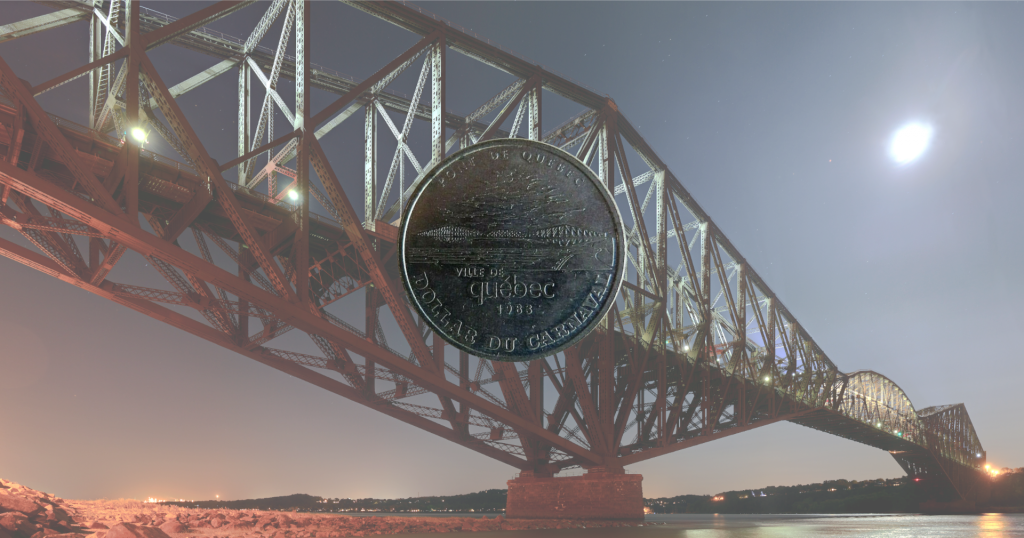On today’s date in 1919, the Québec Bridge (“Pont de Québec” in French) opened to rail traffic after nearly two decades of construction.
The bridge, which crosses the Saint Lawrence River between Sainte-Foy and nearby Lévis, Qué., features the longest cantilevered span in the world with a centre span of 549 metres. The record holds to this day; however, it comes at a cost—the project wasn’t completed for more than 20 years, during which time there were two disasters, resulting in 88 deaths.
“When people use the Québec Bridge – whether they are driving, cycling or walking – they are reminded of what’s possible when Canadians work hard and work together,” Bill Morneau, then finance minister, said in 2019. “We know how important the bridge is to people in the region, the local economy and to Canada’s economy as a whole.”
A FEAT OF ENGINEERING
The Québec Bridge was – and still is – considered a feat of engineering, and rightfully so: before the bridge was built, there was no easy way to cross the Saint Lawrence River.
Before 1919, the only way to enter Québec City from the south was via a ferry or the frozen ice bridge that formed during the winter.
A bridge connecting Québec across the river was discussed as early as 1852 and again in 1867, 1882 and 1884. By 1887, with John A. Macdonald serving as prime minister with his fifth majority government, the Quebec Bridge Company was incorporated by an act of Parliament. The act was revived in 1891 and once again in 1897, a year after Québec East MP Wilfrid Laurier was elected as prime minister.
“The bridge question has again been revived after many years of slumber, and business men in Quebec seem hopeful that something will come of it, though the placing of a subsidy on the statute book is but a small part of the work to be accomplished, as some of its enthusiastic promoters will, ere long, discover,” reads a report published by the defunct Québec Morning Chronicle newspaper in 1897. “Both Federal and Provincial Governments seem disposed to contribute towards the cost, and the City of Quebec will also be expected to do its share.”
Laurier was the bridge’s patron and “ensured that at the turn of the century, in 1900, construction work on the bridge began,” Jacques Jobin, then spokesperson for the Coalition for the Safeguarding of the Québec Bridge (“Coalition pour la sauvegarde du Pont de Québec” in French), told the House of Commons in 1995.
TWO DISASTERS
While a working bridge was completed by the early 20th century, the company responsible for its design and construction, Phoenix Bridge Company, failed in their duty as engineers.
When officials decided to lengthen the bridge, engineers failed to adjust their blueprints. Despite prior concerns about buckling in the half-built bridge, it eventually collapsed in 1907.
“Near the end of the afternoon shift that very day, the entire southern half with the added partially built centre section came crashing down in seconds killing 75 of the 86 workers on shift, injuring those not killed,” reads a 2019 report by Radio Canada International (RCI).
To this day, the collapse remains the world’s worst bridge construction accident. An inquiry blamed the Phoenix Bridge Company and U.S. consulting engineer Theodore Cooper, who led the construction project; however, both parties “seemed to have escaped jail time,” according to the 2019 RCI story.
A different set of engineers made a second attempt at building the bridge; however, it also failed. The bridge’s large span required an innovative approach to build, so the new engineers assembled the bridge’s middle portion onshore before floating it out to the middle of the river and lifting it to complete the span.
In 1916, as the workers put the bridge’s middle portion into place, their crane failed and the massive span fell. Another 13 workers were killed.
Construction continued the following year and was completed in August 1919 at a cost of $25 million.
Today, the bridge holds three highway lanes, one rail line and a pedestrian walkway. It previously carried a streetcar line.
Since 1993, the bridge has been owned by the Canadian National Railway; however, the federal government is working to acquire the bridge to complete its restoration “in a timely manner,” according to a 2019 report from Infrastructure Canada.
In 1995, it was designated a National Historic Site of Canada.
‘CARNAVAL’ TOKENS
In past years, a series of Québec Winter Carnival trade dollars were struck for the province’s annual wintertime festival.
In 1983, one of these “Dollars du Carnaval” featured the Québec Bridge on the reverse alongside the issuing entity, the “Ville de Québec,” and the year-date.
The obverse features the “effigie du Bonhomme Carnaval” alongside the “valeur de $1” and the phrase “non valide apres le 20 Fevrier 1983.”
It was one of three trade dollars struck for the carnival that year.

